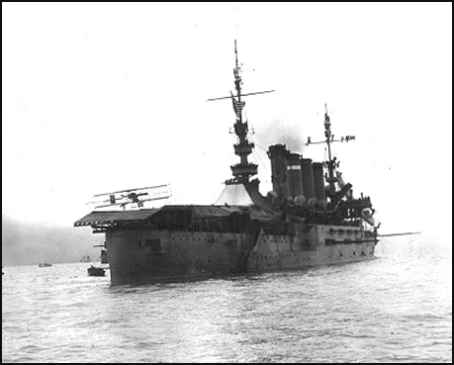The Birth of American Naval Aviation
Early Carriers: 1921-1941

Union balloon ship George Washington Parke Custis
Image source:
U. S. Centennial of Flight Commission
Even before the Wrights proved that aircraft were possible, a French aviation pioneer was already looking at the possibilities of naval aviation. In his 1895 book L'Aviation Militaire, Clement Adler accurately described an aircraft carrier: "...an aircraft carrier will become indispensable. Such ships will be very differently constructed from anything in existance today. To start with, the deck will have been cleared of any obstacles; it will be a flat area, as wide as possible, not conforming to the lines of the hull and will resemble a landing strip. The speed of this ship will have to be at least as great as that of cruisers or even greater...Servicing the airplanes will have to be done below this deck in the hull...Access to this lower deck will be by means of a large elevator long enough and wide enough to take an aircraft with its wings folded...Along the sides will be the workshops of the mechanics responsible for refitting the airplanes and for keeping them always ready for flight." (Quotation from Musciano) It would be sixteen years before Adler's vision was given form.
The United States initially led the development of the aircraft carrier, with several experiments conducted in 1910 and 1911 by aircraft pioneer Eugene Ely, a member of the Curtiss Aircraft flying team. On 14 November 1910, Ely took off in a Curtiss biplane from a specially constructed deck on the bow of the cruiser USS Birmingham, anchored in Hampton Roads, Virginia. Although Ely's aircraft touched the water, he wrestled it back into the air and landed at Willoughby Spit, Norfolk, Virginia.
Shortly after, on 18 January 1911, Ely demonstrated landing-on, using a deck built on the quarterdeck of the battleship USS Pennsylvania, anchored in San Francisco Bay. Not only did Ely land aboard, but 45 minutes later he took off again.
Unfortunately, despite the success of Ely's demonstrations, U. S. Navy interest in shipboard aircraft operations stagnated. Aside from acquiring a few seaplanes and training Naval officers to fly them, the U. S. did not return to carrier development until after World War I. It was left to the British to continue the development of the concept, first with HMS Furious, a less than totally successful conversion employing separate take off and landing decks, then with HMS Argus, the first true through-deck aircraft carrier.
Many early carriers were converted from existing or building ships. Furious started out as a battle cruiser; Argus was originally the Italian merchant ship Conte Rosso, which was under construction in Britain at the start of WWI. Furious joined the Royal Navy in 1917, Argus in 1918 (just too late to see service during the war).
The first U. S. carrier was created by converting the collier AC-3 USS Jupiter in 1920-1921. This resulted in CV-1 USS Langley.
Both the British and the Japanese pioneered in purpose-designed carrier construction. The British began construction of HMS Hermes in 1918, while the Japanese started HIJMS Hosho in 1919. Due to British postwar economies, work on Hermes proceeded very slowly, allowing the Japanese to finish Hosho first, in 1922. Hermes was completed in 1923.
The United States did not build it's first purpose-designed carrier until 1931-1934, with CV-4 USS Ranger.
Meanwhile, all three countries were converting other ships to carriers, partly as a result of the 1921 Washington Naval Treaty, which limited the countries' capital ships. Britain converted the unfinished Chilean battleship Almirante Cochrane to the carrier HMS Eagle (1924), plus the Courageous-class carriers HMS Courageous (1928) and HMS Glorious (1930), both former battlecruisers converted as Furious was. The Japanese converted the battlecruiser HIJMS Akagi (1927) and the battleship HIJMS Kaga (1928), both while building. The Americans converted-while-building the former battlecruisers USS Lexington and USS Saratoga, both completed in 1927. At the time, these Lexington-class carriers were the largest in the world.
As tensions rose during the '20s and '30s, all three countries built additional carriers. The United States' contribution to this early "arms race" were the three purpose-designed Yorktown-class fleet carriers CV-5 (USS Yorktown, CV-6 USS Enterprise & CV-8 USS Hornet) and the one-off light carrier CV-7 USS Wasp.
| The Birth of American Naval Aviation | |||
| CV-1 USS Langley | |||
| Lexington-class Fleet Carriers | CV-2 USS Lexington | CV-3 USS Saratoga | |
| CV-4 USS Ranger | |||
| Yorktown-class Fleet Carriers | CV-5 USS Yorktown | CV-6 USS Enterprise | CV-8 USS Hornet |
| CV-7 USS Wasp | |||
| Top of Page | Home Page | Site Index |










![United States [ Flag of United States ]](http://i572.photobucket.com/albums/ss162/RustyBill/website/flags/us-tn.gif)